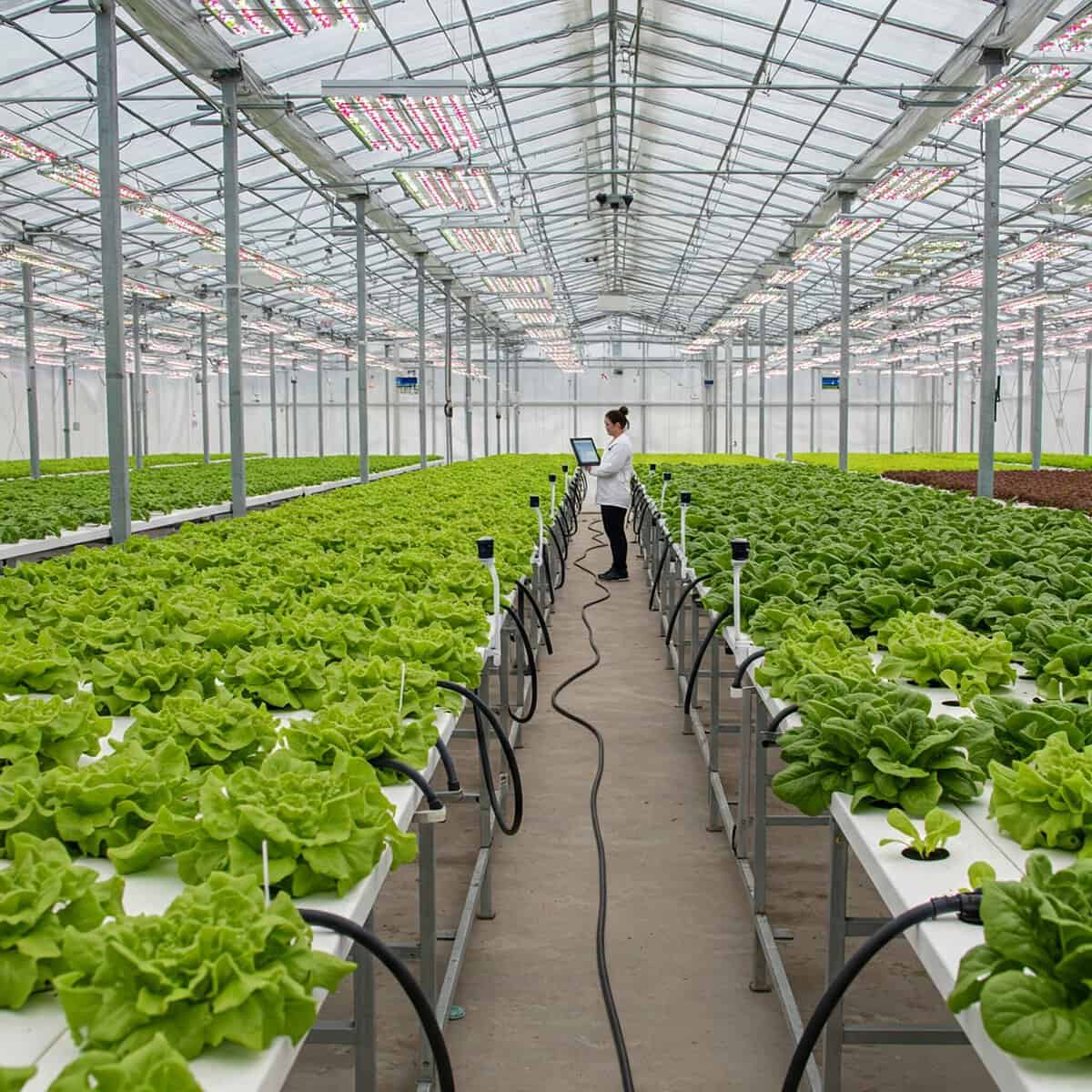Advanced nutrient techniques turn standard fields into high-yield crop zones. Modern farming methods use precision fertilizer systems that deliver specific NPK ratios (nitrogen 10-20%, phosphorus 10-30%, potassium 10-20%) matched to plant growth stages. Real-time soil sensors track nutrient absorption, while automated drip systems distribute liquid fertilizers directly to root zones.
These methods increase crop yields 40-60% over conventional farming practices. Hydroponic setups maximize nutrient uptake efficiency in controlled environments, using 90% less water than traditional methods. Smart nutrient delivery systems might become essential for meeting growing food demands.
Key Takeaway
- Farmers use precision nutrient management to give crops exactly what they need.
- Hydroponics allows plants to grow without soil, making them grow faster.
- Sustainable practices help protect the environment while producing more food.
1. Precision Nutrient Management
- Soil Analysis: Soil testing reveals what nutrients are missing or in excess, helping farmers optimize crop growth. Common tests include pH, mineral content, and nutrient levels like nitrogen, phosphorus, and potassium (N-P-K).(1)
- N-P-K Ratios: These nutrients are crucial for plant growth. Each crop needs a different balance. For example, spinach needs more nitrogen, while tomatoes benefit from more phosphorus. Correct ratios help avoid nutrient imbalances, promoting healthy crops.
- Technology in Farming: Satellites monitor plant health, moisture, and pests from above. Real-time data helps farmers manage water and fertilizers efficiently, preventing overuse and saving resources.
- Benefits: Using soil tests and technology like satellites improves crop yields, reduces waste, and saves money. The right approach leads to healthier crops and better farming decisions.
2. Hydroponic Techniques
Nutrient Film Technique (NFT):
- Plants receive nutrients through a steady, thin stream of water, not soil.
- Roots hang in a sloped channel with a continuous flow of nutrient-rich water, like a tiny waterfall.
- Excess water is collected and reused, minimizing waste.
- NFT is highly efficient and maximizes space.
- Works well for leafy greens like lettuce, herbs, and spinach.
Aeroponics:
- Plants’ roots are suspended in the air, misted with nutrient-laden water.(2)
- Roots get hydrated but “breathe” easier, thanks to the oxygen-rich environment.
- Uses less water, making it ideal for dry regions.
- More sensitive to issues like clogging.
- Works for herbs, strawberries, and larger crops.
Deep Water Culture (DWC):
- Roots are suspended in nutrient-rich water, with bubbles provided by an air pump.
- Air bubbles help roots absorb nutrients and “breathe.”
- Works well for larger plants like tomatoes and peppers.
3. Automated Nutrient Delivery Systems
Credit:By Advanced Nutrients
Labor Efficiency: Saving Time for Farmers
Automated systems act like an extra pair of hands, reducing fatigue.Machines tend to crops efficiently, saving farmers hours of work.Farmers no longer need to inspect plants or manually adjust nutrient levels.Monitoring is done from a screen, freeing up time for other tasks.Systems can run autonomously for up to 12 hours, improving productivity.A California farmer spends less time on water checks, allowing for more rest.Automation reduces labor strain while boosting crop care efficiency.
Error Reduction: More Precision, Fewer Mistakes
Automated systems cut human error, preventing costly mistakes like overwatering.Sensors measure soil moisture, temperature, and light exposure in real-time.Precision ensures plants get exactly what they need, when they need it.A Fresno farmer eliminated nitrogen overfeeding with system adjustments.Water waste reduced by over 30%, promoting sustainability.These systems enhance crop yields by maintaining nutrient balance and health.
4. Isotopic Techniques
Nutrient Tracing
Scientists use isotopes to trace how plants take up nutrients like nitrogen and phosphorus.Isotopes are versions of elements with extra neutrons, helping track nutrients from soil to plant.For example, isotopes can show how much nitrogen fertilizer the plant absorbs.This helps farmers use the right amount of fertilizer, reducing waste and preventing soil imbalances.More efficient fertilizer use can lead to sustainable farming practices.
Drought Resistance Assessment
Isotopes help identify plants that handle drought better than others.They track how water moves through plants and measure water use.This helps spot drought-resistant plants, important for dry regions.Plants that hold onto water longer might survive dry spells when others fail.This research has potential to improve global food security by developing crops suited for tough conditions.
5. Sustainable Practices
Farming has changed from small-scale operations to large industrial farms.The use of chemicals, such as pesticides and synthetic fertilizers, has increased.While these chemicals boost crop yield and control pests, they can degrade soil and harm ecosystems.Some farmers are adopting organic methods, using natural fertilizers like composted manure or alfalfa meal.
These fertilizers help maintain healthy soil, which benefits water systems by reducing runoff.Farmers who switch to natural inputs notice richer soil over time, leading to healthier crops.Organic farming also offers cleaner food options for consumers.Water conservation is another key focus.
Drip irrigation systems deliver water directly to plant roots, using less water than traditional methods.In places like California, drip irrigation has saved up to 60% of water.Rainwater harvesting helps reduce reliance on municipal water sources.These water-saving techniques benefit both the environment and the farmer’s bottom line.
Conclusion
Modern farming merges scientific precision with sustainable methods to maximize crop yields. Farmers utilize advanced nutrient management through hydroponics and automated feeding systems, which deliver exact amounts of minerals to plants. Nuclear isotopic techniques track nutrient uptake in real-time (a method that saves up to 30% of fertilizer use). These integrated approaches support food production while reducing environmental impact through targeted resource application and minimal waste generation.
FAQ
How do I know if my soil actually needs nutrient amendments?
Start with a comprehensive soil test – it’s like getting a health checkup for your dirt. You’ll want to look at NPK levels, pH, and micronutrients. Most agricultural extension offices can help you with this. Once you have your results, you can spot specific deficiencies and avoid wasting money on nutrients your soil doesn’t need. A good tip: keep track of your soil test results over time to spot trends and make better decisions about what to add.
What’s the deal with foliar feeding, and when should I use it?
Think of foliar feeding as a quick energy drink for your plants – it gets nutrients directly to the leaves when they need a boost. It works great for fixing immediate nutrient deficiencies or during critical growth stages like flowering. You’ll want to spray early morning or late evening when leaves can better absorb nutrients. Just remember that foliar feeding isn’t a replacement for good soil fertility – it’s more like a supplement to your regular nutrient program.
How can I make my own organic nutrient solutions at home?
You can brew up some pretty effective nutrients using materials from your own backyard. Compost tea is a favorite – just steep finished compost in water for 24-48 hours with good aeration. Worm castings tea, fermented plant juice, and fish emulsion are other options. The key is maintaining the right temperature and oxygen levels during brewing. These homemade solutions give you both nutrients and beneficial microorganisms.
What’s the best way to prevent nutrient lockout in my crops?
Nutrient lockout is like a traffic jam in your plants – the nutrients are there, but they can’t get where they need to go. Keep your pH in check (usually between 6.0-7.0 for most crops), avoid overfeeding, and maintain good soil structure. If you spot signs of lockout – like yellowing leaves even though you’re feeding regularly – flush the soil with plain water and reset your nutrient program.
How do I adjust nutrient applications for hydroponic systems?
Hydroponics requires a more precise touch with nutrients since there’s no soil buffer. You’ll need to monitor EC (electrical conductivity) and pH daily, and adjust your nutrient solution accordingly. Start with a base solution at about 2/3 strength of what the label recommends, then adjust based on how your plants respond. Remember to change out your nutrient solution completely every 7-10 days to prevent salt buildup.
What role do beneficial microorganisms play in nutrient uptake?
Think of beneficial microbes as your plants’ personal nutrient delivery service. They form networks in the soil that help roots access nutrients more efficiently. These tiny helpers break down organic matter, fix nitrogen from the air, and even protect roots from diseases. Adding products with mycorrhizal fungi or beneficial bacteria can jumpstart this process, especially in soils that have been heavily tilled or treated with chemicals.
How can I tell the difference between nutrient deficiency and disease?
This one trips up even experienced growers. Nutrient issues usually show up in a pattern – older leaves for mobile nutrients like nitrogen, newer leaves for immobile ones like calcium. Disease symptoms tend to be more random and often come with other signs like spots, fuzzy growth, or stem damage. Take photos of problem areas and track how symptoms progress. The pattern and timing of symptoms will help you crack the case.
When should I switch nutrient ratios during the growing season?
Think of your growing season like a marathon – your plants need different fuel at different stages. During early growth, use higher nitrogen ratios to build strong stems and leaves. As flowering approaches, dial back nitrogen and bump up phosphorus and potassium. Keep notes on when you make changes and how your plants respond. Many growers adjust their nutrient mix every 2-3 weeks based on plant development stages.
References
- https://www.farmraise.com/blog/advanced-fertilizer-strategies-and-nutrient-management-techniques
- https://www.alliedacademies.org/articles/maximizing-yields-advanced-techniques-in-hydroponic-farming.pdf
Related Articles
- https://tophydroponicgarden.com/hydroponic-garden-maintenance/
- https://tophydroponicgarden.com/deep-water-culture-system-guide/
- https://tophydroponicgarden.com/hydroponic-systems/
Was this helpful?

I’m Barrie L., a passionate hydroponic gardening enthusiast dedicated to cultivating thriving, soil-less gardens. With a focus on all things hydroponic, I share my expertise on innovative growing techniques and sustainable practices through my blog, tophydroponicgarden.com. As a seasoned hydroponics specialist, my goal is to inspire and guide fellow gardeners in harnessing the power of water-based cultivation for bountiful and eco-friendly harvests. I’m also an author of the book “Hydroponics For Absolute Beginners: Your Step By Step Guide For How To Create An Hydroponics System At Home Without Soil, For Growing Vegetable, Fruit And Herbs.” which is sold on Amazon. Join me on a journey of redefining the way we cultivate plants, one nutrient-rich solution at a time. Happy growing!


